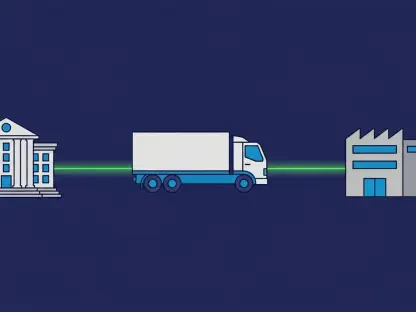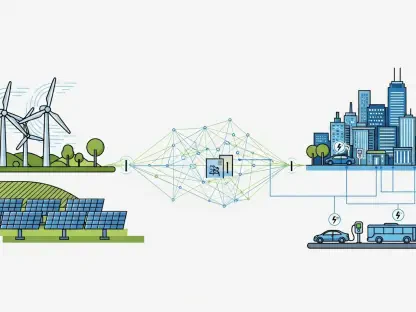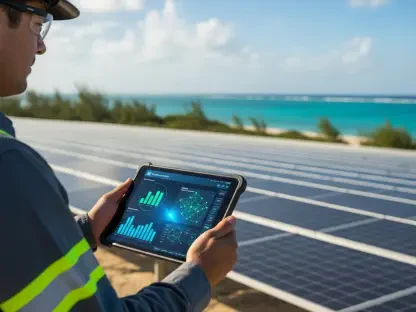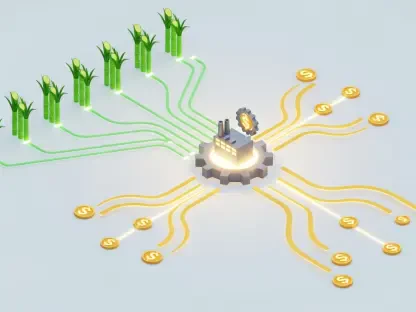The global push towards a sustainable and carbon-free future has accelerated efforts to transform our traditional power grids. With rising concerns over climate change and increasing governmental mandates, the quest for decarbonized electricity generation is more urgent than ever. As renewable energy sources like solar and wind become more prevalent, integrating them into a largely outdated grid infrastructure presents numerous challenges. This has led to a pivotal question: Are smart grids the key to a decarbonized future?
The Urgency of Decarbonization
Global Mandates and Climate Goals
Governments worldwide, including the U.S. and G7 economies, are setting ambitious targets to achieve 100% carbon-free electricity. Driven by the dire need to mitigate the adverse impacts of climate change, these mandates are reshaping national energy policies. Traditional grids, which were designed to handle the steady, predictable output of fossil fuel-based plants, are ill-equipped to manage the intricacies of integrating renewable energy. As these goals draw near, the limitations of the existing grid infrastructure become increasingly apparent.
Additionally, the urgency of these climate goals can’t be overstated. Fossil fuels have long been the backbone of global electricity generation, but their environmental toll is now all too clear. As a result, many countries have committed to phasing out coal and natural gas plants. Achieving this transition without compromising grid reliability and security presents a monumental challenge. The current grid systems were never designed for the intermittency and distributed nature of renewable energy sources like wind and solar, which do not produce a consistent output due to their dependence on weather conditions. This necessitates a transformative approach to grid management and operations.
Challenges of Renewable Integration
Renewable sources like solar and wind pose a unique set of challenges due to their intermittent nature, making their electricity production unpredictable by default. This intermittency creates difficulties in maintaining a balanced and stable grid, especially within the confines of existing systems originally built for a more predictable fuel supply. Effective transportation of this renewable energy from generation sites to areas of demand further complicates the integration process, making it a labyrinthine task for grid operators and stakeholders.
Moreover, the geographical distribution of renewable resources adds another layer of complexity. Wind farms are often located in remote areas far from population centers, while solar farms are usually situated in regions with high sunlight exposure, sometimes in isolated locales. Both scenarios necessitate robust and flexible transmission networks to ensure the efficient and reliable flow of electricity. This requires not only substantial financial investments but also a paradigm shift in how grid operations and maintenance are approached. Modernizing this grid infrastructure to accommodate fluctuating, geographically dispersed energy inputs is critical for transitioning to a renewable-heavy energy mix.
Rising Power Demands
Electric Vehicles and Data Centers
The increasing adoption of electric vehicles (EVs) and the proliferation of energy-intensive data centers add to the existing power demands, fundamentally altering consumption patterns. The growing popularity of EVs poses a significant challenge to the current grid, which must accommodate the concurrent charging requirements of millions of vehicles. As EV ownership proliferates, the strain on the grid is expected to increase, necessitating more robust and scalable grid solutions capable of managing peak loads and ensuring consistent power quality.
Furthermore, data centers, the backbone of our digital economy, are enormous consumers of electricity. These facilities operate 24/7, demanding an uninterruptible power supply to maintain optimal performance. As cloud computing and digital services continue to expand, data center energy consumption is expected to skyrocket, further stressing an already overburdened grid. The combination of these emerging demands underscores the pressing need for a grid system that can adapt agilely and efficiently to these evolving requirements, ensuring a seamless and reliable power supply in an era of digital transformation.
Adapting to Fluctuating Demands
The rise in unpredictable power demands necessitates a rapid transformation of the current grid infrastructure, pushing the boundaries of what traditional grids can handle. The inherent variability of renewable energy sources, coupled with the episodic high demand from EVs and data centers, necessitates a grid system that can dynamically respond to fluctuations. Smart grid technologies emerge as a promising solution to manage these fluctuations efficiently, leveraging cutting-edge innovations to ensure a seamless and reliable power supply.
Smart grids employ advanced metering infrastructure and demand response programs to better match electricity supply and demand in real time. By utilizing real-time data and predictive analytics, smart grids can forecast demand patterns more accurately and adjust operations proactively. This flexibility not only enhances grid stability but also helps in optimizing the use of renewable energy, ensuring that clean energy is utilized effectively and reducing reliance on fossil fuel-based peaker plants. The transformation towards a smart grid is crucial for accommodating the unpredictable nature of modern energy demands while ensuring a reliable, sustainable, and resilient power supply.
Technologies Empowering Smart Grids
Industrial Internet of Things (IIoT) and AI
The adoption of technologies such as the Industrial Internet of Things (IIoT) and artificial intelligence (AI) is pivotal in the shift towards smart grids. IIoT connects various grid components, enabling seamless data collection and communication across the entire grid infrastructure. Intelligent sensors and devices are deployed to monitor the grid’s status in real-time, providing crucial insights into performance, efficiency, and potential irregularities. This continuous connectivity enhances grid transparency, allowing operators to make informed decisions and respond swiftly to any anomalies.
AI further augments these capabilities by analyzing vast amounts of data collected through the IIoT. Machine learning algorithms can predict potential issues before they escalate, optimize energy distribution, and even forecast future energy demands based on historical data and consumption patterns. The integration of AI facilitates more efficient grid management, reducing operational costs and improving overall reliability. This convergence of IIoT and AI creates a smart grid ecosystem that is not only more resilient and efficient but also capable of adapting to the dynamic nature of modern energy landscapes.
Augmented Reality (AR) and Cloud Computing
Augmented Reality (AR) is revolutionizing grid maintenance and diagnostics, providing operators the tools to visualize and address issues in real time. By overlaying digital information onto the physical world, AR aids technicians in quickly identifying and resolving problems. This technology can enhance training procedures and support remote assistance, making it easier to maintain grid reliability and efficiency. AR’s real-time insights significantly reduce downtime and improve the accuracy and speed of repairs and maintenance.
Cloud computing plays a critical role in aggregating and analyzing the colossal volumes of data generated by smart grids. By leveraging the computational power and storage capabilities of the cloud, utilities can gain a comprehensive overview of grid operations. This enables real-time data sharing and collaborative decision-making, enhancing operational efficiency and fostering a more integrated approach to grid management. Moreover, cloud-based platforms facilitate the development of advanced analytics tools and applications, providing utilities with deeper insights into grid performance, customer behavior, and emerging trends. The synergy between AR and cloud computing empowers operators to build a more intelligent, resilient, and adaptive grid framework.
The Role of Digital Twins
Understanding Digital Twins
Digital twins, which are virtual replicas of physical grid components, play a transformative role in modern grid management. These digital counterparts allow for dynamic simulations and real-time monitoring of the grid’s physical assets, providing an invaluable tool for analysis and decision-making. By creating a digital twin of a physical component, operators can predict how different elements will respond to various conditions, simulate potential scenarios, and identify vulnerabilities before they become critical issues.
The insights gained from digital twins enable grid operators to fine-tune their systems, anticipate potential failures, and optimize maintenance schedules. This predictive capability enhances the overall reliability and efficiency of grid operations. By continuously updating the digital twins with real-time data from the grid, operators can maintain an accurate, real-time understanding of grid performance, leading to more informed and proactive decision-making.
Benefits of Real-Time Data Sharing
Real-time data sharing is a cornerstone of smart grid technology, providing deep insights into grid operations and facilitating informed decision-making. By enabling the continuous flow of data among grid components and stakeholders, real-time data sharing helps maintain operational visibility and transparency. This data-driven approach promotes more efficient grid management, allowing operators to quickly identify and address issues, optimize energy distribution, and enhance grid reliability.
Moreover, real-time data sharing fosters collaboration and coordination among various stakeholders, from energy suppliers to consumers. By providing accurate and timely information, it encourages cooperative efforts to manage energy resources, reduce peak demand, and support grid stability. Real-time insights enable grid operators to better forecast energy needs, balance supply and demand, and respond to unexpected disruptions. This enhanced situational awareness is crucial for maintaining a stable and sustainable power supply, supporting the broader goals of decarbonization and energy efficiency.
Distributed Energy Resources (DER)
Localized Generation Units
Investments in Distributed Energy Resources (DER), such as electric vehicles, water heaters, and thermostats, are essential for localized control at the grid edge. These small-scale generation units produce electricity close to the point of consumption, reducing the strain on the central grid and enhancing overall grid resilience. By generating power locally, DER can alleviate congestion on transmission lines, reduce energy losses, and improve service reliability, particularly during peak demand periods.
DERs also provide a flexible and adaptive approach to energy management. They can be activated or deactivated based on real-time grid conditions, helping to balance supply and demand dynamically. This localized generation capability supports the integration of renewable energy sources, as DERs can store excess energy during periods of low demand and release it when needed. By decentralizing power generation and enhancing grid flexibility, DERs play a critical role in creating a more resilient and efficient energy system.
Consumer Participation and Incentives
DER systems empower consumers by enabling real-time monitoring of energy usage and providing insights into consumption patterns. This transparency encourages energy-saving behaviors and promotes greater engagement with energy management. Utilities can leverage DER data to offer incentives for behaviors that benefit the grid, such as shifting usage to off-peak times or participating in demand response programs.
By fostering a collaborative relationship between consumers and energy providers, DER systems help create a more responsive and adaptive grid. Consumers are no longer passive recipients of electricity but active participants in the energy ecosystem. This shift not only enhances grid stability but also supports broader sustainability goals. By encouraging consumer participation and providing incentives, utilities can drive the adoption of energy-efficient practices and technologies, contributing to a more sustainable and resilient power system.
Practical Applications and Case Studies
EDP Renewables’ Hybrid Data Infrastructure
European firm EDP Renewables exemplifies the practical application of smart grid technologies through its innovative use of hybrid data infrastructure. By collecting and analyzing data from millions of streams, the company optimizes wind farm energy production. This dynamic approach allows EDP Renewables to monitor performance, anticipate maintenance needs, and extend the lifespan of its assets. The integration of real-time data and advanced analytics enables the company to make informed decisions, improve operational efficiency, and maximize energy output.
EDP Renewables’ hybrid data infrastructure demonstrates the tangible benefits of leveraging smart grid technologies. By harnessing the power of data, the company can proactively address potential issues, optimize resource utilization, and enhance overall grid reliability. This data-driven approach not only improves performance but also supports sustainability goals by maximizing the use of renewable energy resources. The success of EDP Renewables highlights the critical role of data infrastructure in modernizing grid operations and achieving a decarbonized future.
Dominion Energy’s Cloud-Based Services
Dominion Energy in the U.S. showcases the effective implementation of cloud-based services in smart grid management. By aggregating data from various DER sources, Dominion Energy provides real-time energy insights to customers, enhancing loyalty and competitiveness. This cloud-based approach facilitates the seamless integration of diverse energy resources, optimizing energy distribution and improving overall grid efficiency. The use of cloud computing allows Dominion Energy to offer personalized energy solutions, catering to the unique needs and preferences of its customers.
The practical application of cloud-based services at Dominion Energy underscores the importance of modern technology in creating a responsive and adaptive grid. By leveraging real-time data and cloud-based analytics, the company can enhance operational transparency, improve customer engagement, and drive adoption of sustainable energy practices. This innovative approach not only benefits the grid but also supports broader efforts to achieve a decarbonized energy future. Dominion Energy’s success illustrates the potential of cloud-based services to transform grid management and promote sustainable energy solutions.
Moving Toward a Connected Ecosystem
Collaborative Efforts and Stakeholders
Building a sustainable and resilient grid requires collaboration among diverse stakeholders, including energy generators, grid operators, utilities, and consumers. This interconnected ecosystem fosters transparency and cooperation, driving the transition towards a smart grid. By working together, stakeholders can share valuable insights, coordinate efforts, and leverage each other’s strengths to enhance grid reliability and efficiency. This collaborative approach is essential for addressing the complexities of modern energy demands and achieving decarbonization goals.
The success of a connected ecosystem depends on effective communication, trust, and shared objectives. Stakeholders must be willing to engage in open dialogue, share information, and collaborate on innovative solutions. By fostering a culture of cooperation, the energy industry can create a more resilient and adaptive grid infrastructure that is capable of meeting the dynamic needs of the future. This collective effort is crucial for unlocking the full potential of smart grid technologies and driving the transition towards a sustainable energy system.
The Future of Smart Grids
The global push for a sustainable, carbon-free future is driving major transformations in our traditional power grids. With rising concerns about climate change and increasing government mandates, the need for decarbonized electricity generation has become more urgent than ever. As renewable energy sources like solar and wind become more widespread, the challenge lies in integrating them into a largely outdated grid infrastructure. This situation raises a critical question: Are smart grids the solution to achieving a decarbonized future?
Smart grids are advanced electrical grids that use technology to monitor and manage the distribution of electricity efficiently. They promise greater resilience, flexibility, and the ability to incorporate a diverse range of energy sources, including renewables. By providing real-time data, smart grids can help balance supply and demand, reduce energy waste, and facilitate quicker responses to outages and disruptions. These capabilities are essential as we move towards a future where renewable energy plays a central role.
However, the transition to smart grids isn’t without its hurdles. Updating existing infrastructure requires substantial investment and coordinated efforts among stakeholders, including utility companies, governments, and consumers. Additionally, cybersecurity concerns need to be addressed to protect the grid from potential threats. Despite these challenges, the potential benefits of smart grids make them a promising pathway to a sustainable, decarbonized future.









